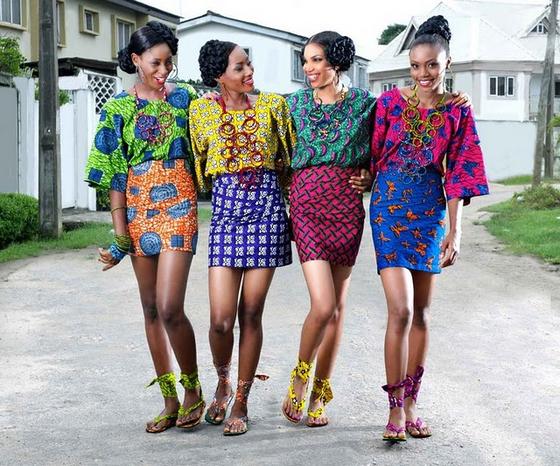
African inspired fashion has seen its high point these past couple of years. The fad has received major presence on the runway all over the world. Western and non- African designers alike have infused their styles with African designs, celebrities and public figures are loving and wearing these designs and the industry in Africa seems to be experiencing a tremendous boost.
But have you ever wondered what African-inspired fashion is? Have you wondered about the inception of African fashion? How this craze started? And where it's headed? If you have ever asked these questions, this piece might just help enlighten you.
For those who don’t know, African inspired fashion is identified by the use of African print fabrics, such as Kente, Ankara or the wax print, and the embodiment of African themes in designer creations. This also means that the trend is inspired by Africans and is not necessarily made in Africa.
Some few years back, the wax print or Ankara used to be a fabric which had no fashion value at all, at least to the younger generation. Back then, the designs were not as exotic or as diverse as we see them today. They were only seen at weddings or traditional celebrations and could only be fashioned in a particular way, in the traditional Kaba and slit or top and wrapper. Even more so, the prints were most popular with dressmakers in Africa and not with designers as we see these days.
A great transformation however took place in the 2000s when the print media (especially the Nigerian print media) began popularizing African fashion locally with spreads of varied wax print styles and designs in every edition of their publications. Nevertheless, African print manufacturers  were compelled to produce more wax print to meet the demands of the people. One of the challenges faced by these manufacturers was the need to also produce exclusive designs for the market. According to my mother this was because some high class personalities and public figures were beginning to get offended by the unflattering way some womenfolk or traders wore the wax print (especially similar wax print worn by them for their traditional occasions) to sell petty items outside.
were compelled to produce more wax print to meet the demands of the people. One of the challenges faced by these manufacturers was the need to also produce exclusive designs for the market. According to my mother this was because some high class personalities and public figures were beginning to get offended by the unflattering way some womenfolk or traders wore the wax print (especially similar wax print worn by them for their traditional occasions) to sell petty items outside.
She even used this illustration to explicate her point, “How would you feel if you were beautifully clad in your African print to a wedding and along the way you meet a woman selling some petty things or wares, tying that same cloth as wrapper?” I guess her question didn’t need an answer because the question was clearly a rhetorically one.
Consequently, the exposure of African designs became more intense on both the local and international market. One of the key players in the augmentation of African inspired fashion was the fashion designer. Fashion designers such as Kofi Ansah, Joyce Ababio, Abba Folawiyo, Olujimi King (the old schools) paved the way for the many new schools like Deola Sagoe, Aisha Obuobi (Christie Brown) , Ozwald Boateng, Duro Olowu and Lisa Folawiyo and the bigger epiphenomenon we see today .These old school designers, although historically important to the revolution of African fashion, were unable to bridge the generation gap and exceed the local market, which the newer generation of African designers have been able to do with their creative designs.
Today, Deola Sagoe and Duro Oluwo have created a reputation for themselves in the fashion industry so much that Lydia Hearst and Anika Noni-Rose have been spotted wearing their ingenious designs. Duro Oluwo’s impeccable designs have even won the heart of the first lady of the United States of America, Michelle Obama. Ghanaian designer, Aisha Obuobi (of the Christie Brown Label) who is not only in the business of making clothes, has also recreated African accessories and jewelries. Her recent feat being the Vibe magazine shoot which had Alicia Keys wearing one of spectacular necklaces.

(Ozwald Boateng's African inspiried blazers)
These African designers have not only inspired themselves but have also inspired international designers and clothing lines. Marc Jacobs, Givenchy, Eley Kishimoto, Jean Paul Gaultier, Thakoon, Louis Vuitton, Diane Von Furstenberg, Gwen Stefani, Dries van Noten, Kenzo and Paul Smith to mention a few have also caught the African prints fever. They have included them in their collections and have made clothes, accessories and jewelry out of the fabrics. Clothing lines such as Suno and Boxing Kitten are also doing a great job promoting African print with their works.
Fashion icons like Beyoncé, Fergie and Rihanna have rocked designs from these lines. The fashion industry in Africa is also booming with creative designers yet to break through the international fashion industry like Aya Morrison in the bikini business, Msimps in the shoe and clutch making business, Poqua in the cloth making business and Mina Evans in clothing lines.

But even with all the growth and impact in the fashion industry, fashion’s conflicted love affair with Africa goes on and Africa isn’t getting the recognition it deserves. I guess that is a whole new discussion for another day. For now, the future looks bright and the staying power of African fashion depends on us Africans. Hence, if we want to see the improvement in this industry in Africa we need to create the opportunity for young innovative people to exhibit the creativity they have in the industry. The fashion industry is big business and at this stage of our progress, we cannot afford to sit on our oars. My view is that the spotlight is not on African fashion for nothing, it is only up to us to use the opportunity given us to showcase the creativity that exists on the continent.










